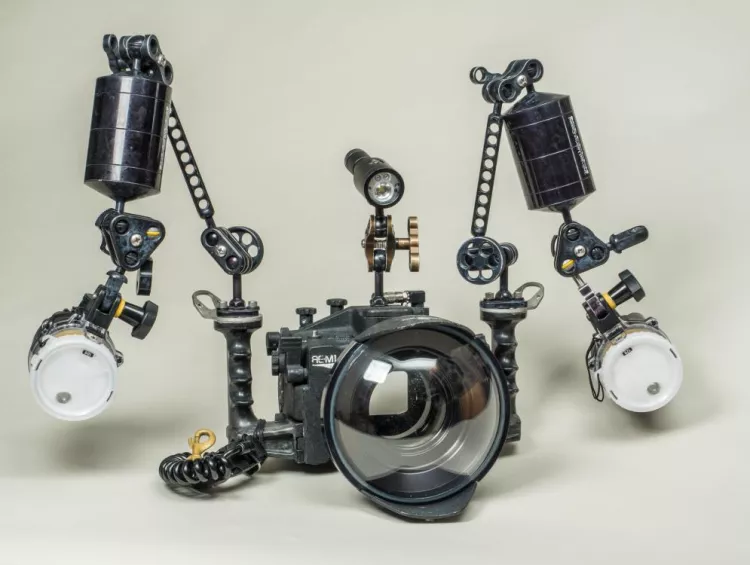With the abundance of choices available on the market today, choosing the right camera and underwater housing that fits your needs can be a daunting and bewildering task. Larry Cohen offers advice, insights and tips to help underwater photographers make the best selection.
Contributed by
Factfile
Larry Cohen and Olga Torrey are well-traveled and published underwater photographers based in New York City, USA.
They offer underwater photography courses and presentations to dive shops, clubs and events.
For more information, visit: liquidimagesuw.com and fitimage.nyc.
The camera
Sensors. Before spending your hard-earned money on a camera for shooting underwater, you do need to look for certain features. The larger the camera sensor, the more information the sensor will hold. This translates to better shadow and highlight details (dynamic range). Images will have less noise when shooting at high ISOs. Having a larger sensor is more important than the number of megapixels. This is why a large interchangeable lens camera that is 24 megapixels will produce better image quality than a small point-and-shoot camera with 24 megapixels. These days, there are a number of small point-and-shoot cameras with a built-in lens that have a large sensor; these cameras could be used effectively underwater.
Manual mode. Manual exposure control is another important feature. When shooting with strobes, it is best to shoot in manual mode, so you can use your shutter speed to control the background ambient light exposure. The shutter speed will have very little effect on the strobe exposure. The strobe’s power dial should be used to control the foreground exposure. Since the aperture will affect both the background ambient light and the strobe exposure on the subject, this should not be changed as often.
RAW files & autofocus. Since most underwater images will need some post processing, it is important that your camera can capture RAW files. It is also important that the camera can autofocus in low light and can focus at a reasonably fast speed.
Compact. The more compact the camera, the smaller the housing. With airlines increasing luggage fees and reducing the weight of carry-on luggage, the smaller your gear, the easier it will be to travel with it.
Back-up body. You should also buy a camera in a price range so you could afford two camera bodies. This way, you do not have to remove the camera from the housing for surface photography, and you have a back-up for shooting underwater.
Camera type. Digital Single Lens Reflex (DSLR) cameras have been the main tool for serious underwater photography, while point-and-shoot cameras have been used by the occasional shooter. These days, many small point-and-shoot cameras have the features listed above, but having a built-in lens has some limitations. Interchangeable lens mirrorless cameras have the small-size advantage while still having the above features and the flexibility of different lenses.
Housing availability. Another often overlooked feature is to ensure that there is a housing for your kind of diving available for your camera. Many people buy a camera and then try to get a housing. Housing manufacturers produce housings for a limited number of camera models. If you are a technical diver doing 100m dives and the only housing available is rated to 50m for your camera, you will not be able to shoot on your dives.
The housing
Material. The first thing to consider is the material the housing is made of. Aluminum and polycarbonate are the two main materials. Aluminum housings are more robust and are usually rated deeper. Polycarbonate housings are less expensive and lighter.
Buoyancy. It is best to get a housing that is close to neutrally buoyant or slightly negative. You should always have the housing attached to your harness. This way, you can let go of the housing without losing it. A positively buoyant housing is very annoying. When you have it attached to your harness and you let go, the housing will float up and hit you in the face. If the tether breaks, your housing could float away.
The housing’s buoyancy will vary depending on the attached port. Buoyancy can be easily adjusted. Housings that are negatively buoyant can be adjusted by adding floats, and weight can be added to positively buoyant housings.
Lens ports. If you are putting an interchangeable lens camera in a housing, it is important that the lenses you want to use are on the manufacturer’s lens port chart. The chart will let you know the correct port, extensions, zoom or focus rings that are needed for the lens. Manufacturers do not support all lenses but do support the most popular and practical lenses for shooting underwater. Nowadays, it is popular to use lenses from one camera brand on another camera brand by using an adapter. Remember that the lens with the same adapter has to be on the lens port chart.
If you are putting a point-and-shoot camera with a built-in lens in a housing, it is important that the housing’s built-in lens port has filter threads. This way, you can add a wide-angle or macro conversion lens to the front of your housing. These lenses can be added to the housing or removed underwater. A wide-angle lens will allow you to get closer to your subject. This way, you have less water between the lens and the subject. This will increase image quality. All good point-and-shoot cameras have a macro mode. Using a macro conversion lens will give you more magnification with a larger subject-to-lens distance. This way, you do not scare shy marine life, and you have more room for your lights.
Access to controls. The housing you choose should allow access to all important camera controls. At the very least, this includes the shutter release, menu, image playback, delete, flash on/off, ISO, white balance, exposure mode, exposure compensation, aperture and shutter control. Being able to set up the camera and housing for back-button focus is useful.
Where the controls are located on the housing is important. At times, this is dictated by where the controls are located on the camera. It is ideal to have two different dials to control the shutter speed and aperture. Since one tends to change the shutter speed often, it is nice to be able to access that control and the shutter release without taking one’s hand off the housing’s handle.
Strobe connection. Another consideration is how external strobes sync to the camera. Some housings have a bulkhead for attaching a sync cord. This method has a hot shoe connection inside the housing and a waterproof bulkhead on the outside to plug in the sync cord. This method has many failure points. When the strobe does not fire, the problem could be the sync cord, hot shoe connection, bulkhead on the housing or the bulkhead on the strobe.
Other housings use fiber optic cables. These housings have two fiber optic cable ports in front of the camera’s built-in flash. Fiber optic cables get plugged into these ports and into a port on the external strobe in front of a built-in slave trigger. When the camera’s flash fires, the light travels up the cable and fires the external strobe. This system is very secure. The problem is the camera’s flash will deplete the camera’s battery quickly, and you have to wait for the camera’s flash to recycle. This is usually much slower than the external strobe. Another problem is many professional cameras do not have a built-in flash.
Many housing manufacturers include an LED trigger, so you can use fiber optic cables with cameras that do not have a built-in flash. LED triggers are sometimes offered as an optional accessory. These are usually for housings for cameras that have a flash, but the photographer wants to save camera battery power and needs faster recycle times. It is important that your external strobes have a built-in slave trigger sensitive enough to be fired with an LED trigger. Not all strobes will fire in this way and might require the image-maker to invest in new strobes. Some housing manufacturers offer both fiber optic ports and bulkheads. Others offer fiber optic ports and optional bulkheads.
Mechanics. The mechanics of the housing is important. Closing the housing should be easy and secure. This is true about the port locking system. The camera tray is a small but important feature of any housing. The tray holds the camera in place and needs to be locked in position easily. This allows the housing’s control to line up correctly with the controls on the camera.
Moisture alarm. Moisture alarms have been offered in housings for decades. They provide sound and visual alarms which tell you when there is water in the housing. The problem is that by the time you get the warning, it is too late. Vacuum seal systems are a relatively new feature on many housings. You create a vacuum in the housing with a pump. The alarm goes off if that vacuum is broken. If air gets in the housing, so will water.
The best choice of housing will be different for every underwater photographer. Use the above features as a starting point to pick the perfect housing for your needs. ■



































